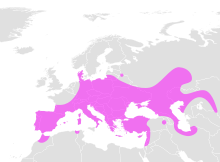European Pond Turtle
| European pond turtle | |
|---|---|
 |
|
| Scientific classification | |
| Kingdom: | Animalia |
| Phylum: | Chordata |
| Class: | Reptilia |
| Order: | Testudines |
| Family: | Emydidae |
| Subfamily: | Emydinae |
| Genus: | Emys |
| Species: | E. orbicularis |
| Binomial name | |
|
Emys orbicularis (Linnaeus, 1758) |
|
 |
|
| The range of the European pond turtle. | |
| Synonyms | |
|
|
The European pond turtle (Emys orbicularis), also called the European pond terrapin, is a long-living freshwater species of turtle.
It is found in southern and central Europe, West Asia and North Africa. In the early post-glacial period, the pond turtle had a much wider distribution, being found as far north as southern Sweden. It became extinct in Great Britain due to climate change.
In France, there are six large remaining populations, all deteriorating; it is the most endangered reptile of the country.
In Switzerland, the European pond turtle was extinct at the beginning of the twentieth century and reintroduced since 2010.
Emys orbicularis turtles prefer to live in wetlands surrounded by a large proportion of natural, wooded, landscape. Specimens of Emys orbicularis are also found in upland environments for feeding.Emys orbicularis is usually considered semi-aquatic, as their terrestrial movements can span 1000 meters, and occasionally found traveling up to 4000 meters, away from the water.
Historically, Emys orbicularis had been maintained as pets; however, this practice has been prohibited due to protection laws. Due to human impact, turtles have been found to be relocated in areas distant from their origin. However, it is possible to localize and indicate a region of origin with genetic testing.
The European pond turtle is a medium size turtle and varies quite a bit across its distribution, from 12 to 38 cm length. Its shell is brown with a hint of green, spotted yellow.
An important factor that affects Emys orbicularis development is temperature and thermal conditions. It has been reported that differential growth rates of the same species occur, including variation of body size and clutch sizes, because of varying temperatures in certain areas. Due to evident patterns of sexual dimorphism, Emys orbicularis adult males are always found to be smaller than females. In males, smaller plastrons offer them a wider mobility compared to females. In females, due to their differential diet and foraging habits, there may be a correlation to an adaptive effect on their skull and head morphology.
...
Wikipedia

